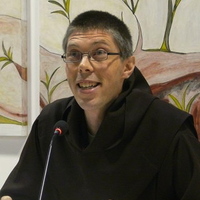
Christof Betschart (o.c.d.)
Projet d’habilitation à la Faculté de théologie de l’Université de Fribourg (CH) en collaboration avec le Prof. Barbara Hallensleben.
Projet d’habilitation: L’humain, image filiale de Dieu. Une anthropologie théologique en dialogue avec l’exégèse
L’image de Dieu est proposée par le Concile Vatican II comme un concept clé d’une anthropologie théologique. Notre projet élabore une interprétation d’abord christologique, puis filiale de l’imago Dei en constant dialogue avec l’exégèse contemporaine. L’interprétation christologique signifie que le Christ lui-même est l’image de Dieu (Col 1,15 ; 2 Co 4,4) alors que les humains sont créés d’après cette image (Gn 1,26-28 ; 5,1-3 ; 9,6) et destinés à s’y conformer (Rm 8,29 ; 2 Co 3,18 ; Col 3,9-10). Cette thèse sera située par rapport aux questionnements du 20e siècle sur le rapport entre christologie et anthropologie (en lien avec Barth, Balthasar, Rahner, Kasper et Pannenberg) ainsi que sur nature et grâce (surtout en lien avec Lubac). L’interprétation filiale concrétise ensuite de manière originale la réflexion sur l’image de Dieu. L’idée clé est que la vision dynamique de l’image de Dieu s’applique également à la filiation divine. En référence au Fils de Dieu, chaque humain est déjà fils ou fille de Dieu par création, mais doit encore le devenir dans le sens d’une relation filiale réconciliée et mûrie par grâce (la filiation adoptive chez Paul). Cette interprétation filiale devrait sortir la théologie de l’image de son christocentrisme unilatéral en y introduisant la dimension trinitaire, pneumatologique et ecclésiale, mais aussi en fondant l’interprétation écologique de l’image préconisée dans la Genèse.
Der Mensch als Gottes Bild und Kind. Eine theologische Anthropologie im Dialog mit der Exegese
Die Gottebenbildlichkeit wird vom Zweiten Vatikanischen Konzil als Schlüsselkonzept einer theologischen Anthropologie vorgeschlagen. Unser Projekt entwickelt im ständigen Dialog mit der zeitgenössischen Exegese eine zunächst christologische und dann eine Interpretation der imago Dei im Sinne der Gotteskindschaft. Die christologische Auslegung bedeutet, dass Christus selbst das Ebenbild Gottes ist (Kol 1,15; 2 Kor 4,4), während der Mensch nach diesem Bild geschaffen (Gen 1,26-28; 5,1-3; 9,6) und dazu bestimmt ist, ihm zu entsprechen (Röm 8,29; 2 Kor 3,18; Kol 3,9-10). Diese These wird im Zusammenhang mit den Fragen des 20. Jahrhunderts nach dem Verhältnis von Christologie und Anthropologie (bei Barth, Balthasar, Rahner, Kasper und Pannenberg) sowie von Natur und Gnade (insbesondere bei Lubac) gestellt. Die Interpretation der Gottebenbildlichkeit als Gotteskindschaft impliziert, dass die dynamische Sichtweise der Gottebenbildlichkeit auch für die Gotteskindschaft gilt. In Bezug auf den Gottessohn ist jeder Mensch bereits durch die Schöpfung Sohn oder Tochter Gottes, aber noch nicht im Sinne einer aus Gnade versöhnten und gereiften Kindschaft (Adoptivkindschaft bei Paulus). Diese gotteskindschaftliche Interpretation kann die Gottebenbildlichkeitslehre aus einem einseitigen Christozentrismus herausführen, indem sie die Gottebenbildlichkeit trinitarisch, pneumatologisch und ekklesial situiert, sowie die ökologische Interpretation der Gottebenbildlichkeit in der Genesis begründet.
The human being as filial image of God. A theological anthropology in dialogue with exegesis
The image of God is proposed by the Second Vatican Council as a key concept for a theological anthropology. In the present study, my aim is to develop an interpretation of the imago Dei which is both Christological and filial, through constant reference to contemporary exegesis. In the Christological interpretation of the image of God, we consider Christ himself as God’s image (Col 1:15; 2 Cor 4:4), and humans as created according to God’s image (Gen 1:26-28; 5:1-3; 9:6) and destined to be brought into conformity with this image (Rom 8:29; 2 Cor 3:18; Col 3:9-10). This Christological understanding of the image of God is then examined within the context of 20th century thought on Christology and anthropology (in dialogue with Barth, Balthasar, Rahner, Kasper and Pannenberg) and on nature and grace (especially in dialogue with Lubac). We then proceed to consider the filial interpretation of the imago Dei and the original contribution to theological reflection this interpretation provides. The key thought developed here is that the dynamic vision of the image of God also applies to divine filiation. Every human being is a son or daughter of God by creation, and also has yet to become a son or daughter of God within a filial relationship, reconciled and matured by grace, in reference to the Son of God (adoptive filiation in Paul). This filial interpretation has the potential to bring about a shift in the theology of the image leading from one-sided Christocentrism to a full manifestation of the Trinitarian, pneumatological and ecclesial dimensions of the imago Dei, while also founding the ecological interpretation of the image promoted in Genesis.
